Real-Time Monitoring System for a Utility-Scale Photovoltaic Power Plant
Abstract
:1. Introduction
1.1. Brief Overview and Key Innovations
1.2. Outline of the Paper
2. PV-on Time System Description
2.1. Measurements in Inverters: Smart Power Quality Analysis
2.2. Wireless Sensor Network
2.3. Weather Station
2.4. Synchronization System
2.5. Communication System
Communication Services IEC 61850
2.6. Monitoring and Processing System
2.6.1. Data Processing
2.6.2. On Time Monitoring System
3. Results
3.1. Real-Time Acquisition in the cRIO Systems
3.2. Synchronization and Communication Procedures of Distributed Measurements
3.3. Data Processing System
3.4. Monitoring on Time
4. Conclusions
Acknowledgments
Author Contributions
Conflicts of Interest
Abbreviations
| AC | Alternating Current |
| API | Application Programming Interface |
| ACSI | Abstract Communication Service Interface |
| CRIO | CompactRIO |
| CSV | Comma-Separated Values |
| DA | Data Attributes |
| DAC | Digital to Analog Converter |
| DB | Database |
| DC | Continuous Current |
| DER | Distributed Energy Resource |
| DO | Data Objects |
| DPVA | PV Array characteristics |
| DPVM | PV Module ratings |
| DSO | Distribution System Operator |
| DUT | Device Under Test |
| EE | Enterprise Edition |
| EIS | Enterprise Information System |
| EJB | Enterprise Java Beans |
| FTP | File Transfer Protocol |
| GOOSE | Generic Object Oriented Substation Event |
| GPS | Global Positioning System |
| GSE | Generic Substation Event |
| HTTP | Hypertext Transfer Protocol |
| HTTPS | Hypertext Transfer Protocol Secure |
| IEC | International Electrotechnical Commission |
| INV | Inverter |
| JAX-RS | Java API for RESTful Web Services |
| JDBC | Java Database Connector |
| JPA | Java Persistence API |
| JSON | JavaScript Object Notation |
| LABVIEW | Laboratory Virtual Instrument Engineering Workbench |
| LD | Logical Devices |
| LN | Logical Nodes |
| MMDC | DC Measurement |
| MMET | Meteorological Information |
| MMS | Manufacturing Message Specification |
| MMTR | Metering 3 Phase |
| MMXU | Measurement |
| NI | National Instruments |
| NIST | National Institute of Standards and Technology |
| NTP | Network Time Protocol |
| O&M | Operating and Maintenance costs |
| ODBC | Open Database Connectivity |
| PQ | Power Quality |
| RMS | Root Mean Square |
| PTP | Precision Time Protocol |
| PV | Photovoltaic |
| QFVR | Frequency Variation |
| QITR | Current Transient |
| QVTR | Voltage Transient |
| QVVR | Voltage Variation |
| RESTFUL | Representational State Transfer |
| RSYN | Synchronism-check |
| RTD | Resistance Temperature Detector |
| RTOS | Real-Time Operating System |
| SCADA | Supervisory Control And Data Acquisition |
| SNTP | Simple Network Time Protocol |
| SPQA | Smart Power Quality Analyzer |
| SQL | Structured Query Language |
| ST | Solar Tracker |
| SV | Sample Value |
| TC | Transformer Center |
| THD | Total Harmonic Distortion |
| TS | Test Set |
| UTC | Universal Time Coordinate |
| VARSTR | Voltage variation Start event in progress |
| VI | Virtual Instrument |
| WSN | Wireless Sensor Network |
| XML | Extensible Markup Language |
| ZINV | Inverter for converting direct current to alternating current (DC→ AC) |
References
- Chine, W.; Mellit, A.; Pavan, A.M.; Kalogirou, S. Fault detection method for grid-connected photovoltaic plants. Renew. Energy 2014, 66, 99–110. [Google Scholar] [CrossRef]
- European Photovoltaic Industry Association—EPIA. Available online: http://www.epia.org/home (accessed on 24 February 2016).
- Global Solar Installations to Reach 64.7 GW in 2016. Available online: http://solarindustrymag.com/global-solar-installations-to-reach-647-gw-in-2016 (accessed on 15 March 2016).
- IHS Forecasts Global Solar Market to Top 69GW in 2016. Available online: http://www.pv-tech.org/news/ihs-forecasts-global-solar-market-to-top-69gw-in-2016 (accessed on 15 March 2016).
- Strasser, T.; Andren, F.; Kathan, J.; Cecati, C.; Buccella, C.; Siano, P.; Leitao, P.; Zhabelova, G.; Vyatkin, V.; Vrba, P.; et al. A review of architectures and concepts for intelligence in future electric energy systems. IEEE Trans. Ind. Electron. 2014, 62, 2424–2438. [Google Scholar] [CrossRef]
- Silvestre, S.; da Silva, M.A.; Chouder, A.; Guasch, D.; Karatepe, E. New procedure for fault detection in grid connected PV systems based on the evaluation of current and voltage indicators. Energy Convers. Manag. 2014, 86, 241–249. [Google Scholar] [CrossRef]
- Petrone, G.; Spagnuolo, G.; Teodorescu, R.; Veerachary, M.; Vitelli, M. Reliability issues in photovoltaic power processing systems. IEEE Trans. Ind. Electron. 2008, 55, 2569–2580. [Google Scholar] [CrossRef]
- Zhang, P.; Li, W.; Li, S.; Wang, Y.; Xiao, W. Reliability assessment of photovoltaic power systems: Review of current status and future perspectives. Appl. Energy 2013, 104, 822–833. [Google Scholar] [CrossRef]
- Jain, N.; Singh, S.N.; Srivastava, S.C. A generalized approach for dg planning and viability analysis under market scenario. IEEE Trans. Ind. Electron. 2013, 60, 5075–5085. [Google Scholar] [CrossRef]
- Gungor, V.C.; Sahin, D.; Kocak, T.; Ergut, S.; Buccella, C.; Cecati, C.; Hancke, G.P. A survey on smart grid potential applications and communication requirements. IEEE Trans. Ind. Inform. 2013, 9, 28–42. [Google Scholar] [CrossRef]
- Meliones, A.; Apostolacos, S.; Nouvaki, A. A web-based three-tier control and monitoring application for integrated facility management of photovoltaic systems. Appl. Comput. Inform. 2014, 10, 14–37. [Google Scholar] [CrossRef]
- Koohi-Kamali, S.; Rahim, N.; Mokhlis, H. Smart power management algorithm in microgrid consisting of photovoltaic, diesel, and battery storage plants considering variations in sunlight, temperature, and load. Energy Convers. Manag. 2014, 84, 562–582. [Google Scholar] [CrossRef]
- Where the Energy Storage Expansion Will Happen First and Why. Available online: http://www.utilitydive.com/news (accessed on 3 March 2016).
- Etherden, N.; Bollen, M.H.J. Dimensioning of energy storage for increased integration of wind power. IEEE Trans. Sustain. Energy 2013, 4, 546–553. [Google Scholar] [CrossRef]
- Santiago, I.; Trillo-Montero, D.; Luna-Rodriguez, J.J.; Real-Calvo, R.; Moreno-Munoz, A. Analysis of Variations in PV Production, Focussing on Storage and Dispatchability Decisions. In Proceedings of the 2015 IEEE International Conference on Industrial Technology (ICIT), Seville, Spain, 17–19 March 2015; pp. 2884–2889.
- Moreno-Garcia, I.M.; Pallares-Lopez, V.; Gonzalez-Redondo, M.; Lopez-Lopez, J.; Varo-Martinez, M.; Santiago, I. Implementation of A Real Time Monitoring System for a Grid-Connected PV Park. In Proceedings of the 2015 IEEE International Conference on Industrial Technology (ICIT), Seville, Spain, 17–19 March 2015; pp. 2915–2920.
- Moreno-Muñoz, A. (Ed.) Power Quality: Mitigation Technologies in a Distributed Environment; Springer: Berlin, Germany, 2007.
- Varaiya, P.P.; Wu, F.F.; Bialek, J.W. Smart Operation of Smart Grid: Risk-Limiting Dispatch. IEEE Proc. 2011, 99, 40–57. [Google Scholar] [CrossRef]
- Moradi-Shahrbabak, Z.; Tabesh, A.; Yousefi, G.R. Economical Design of Utility-Scale Photovoltaic Power Plants With Optimum Availability. IEEE Trans. Ind. Electron. 2014, 61, 3399–3406. [Google Scholar] [CrossRef]
- Etherden, N. Increasing the Hosting Capacity of Distributed Energy Resources Using Storage and Communication. Master’s Thesis, Luleå University of Technology, Luleå, Sweden, May 2012. [Google Scholar]
- Chouder, A.; Silvestre, S. Automatic supervision and fault detection of PV systems based on power losses analysis. Energy Convers. Manag. 2010, 51, 1929–1937. [Google Scholar] [CrossRef]
- Shariff, F.; Rahim, N.A.; Hew, W.P. Zigbee-based data acquisition system for online monitoring of grid-connected photovoltaic system. Expert Syst. Appl. 2015, 42, 1730–1742. [Google Scholar] [CrossRef]
- Trillo-Montero, D.; Santiago, I.; Luna-Rodriguez, J.; Real-Calvo, R. Development of a software application to evaluate the performance and energy losses of grid-connected photovoltaic systems. Energy Convers. Manag. 2014, 81, 144–159. [Google Scholar] [CrossRef]
- Prieto, M.J.; Pernía, A.M.; Nuño, F.; Díaz, J.; Villegas, P.J. Development of a wireless sensor network for individual monitoring of panels in a photovoltaic plant. Sensors 2014, 14, 2379–2396. [Google Scholar] [CrossRef] [PubMed]
- Molina-García, A.; Campelo, J.C.; Blanc, S.; Serrano, J.J.; García-Sánchez, T.; Bueso, M.C. A decentralized wireless solution to monitor and diagnose pv solar module performance based on symmetrized-shifted gompertz functions. Sensors 2015, 15, 18459–18479. [Google Scholar] [CrossRef] [PubMed]
- IEEE. IEEE 1588:2008, IEEE Standard for a Precision Clock Synchronization Protocol for Networked Measurement and Control Systems; IEEE Instrumentation and Measurement Society: New York, NY, USA, 2008; pp. 1–269. [Google Scholar]
- Wischnewski, R.; Brueckner, M.; Porelli, A. Time Synchronization with White Rabbit—Experience from Tunka-HiSCORE. In Proceedings of the 34th International Cosmic Ray Conference, The Hague, The Netherlands, 30 July–6 August 2015.
- Serrano, J.; Alvarez, P.; Cattin, M.; Garcia-Cota, E.; Lewis, J.; Moreira, P.; Wlostowski, T.; Gaderer, G.; Loschmidt, P.; Bar, R.; et al. The White Rabbit Project. In Proceedings of the ICALEPCS TUC004, Kobe, Japan, 12–16 October 2009.
- Wiki-Solar. Available online: http://wiki-solar.org/data/index.html (accessed on 24 February 2016).
- IFC—International Finance Corporation. Utility-Scale Solar Photovoltaic Power Plants: A Project Developer’s Guide; Technical Report; International Finance Corporation: Washington, DC, USA, 2015. [Google Scholar]
- Fekete, K.; Klaic, Z.; Majdandzic, L. Expansion of the residential photovoltaic systems and its harmonic impact on the distribution grid. Renew. Energy 2012, 43, 140–148. [Google Scholar] [CrossRef]
- Chicco, G.; Schlabbach, J.; Spertino, F. Experimental assessment of the waveform distortion in grid- connected photovoltaic installations. Sol. Energy 2009, 83, 1026–1039. [Google Scholar] [CrossRef]
- Hengsritawat, V.; Tayjasanant, T.; Nimpitiwan, N. Optimal sizing of photovoltaic distributed generators in a distribution system with consideration of solar radiation and harmonic distortion. Int. J. Electr. Power Energy Syst. 2012, 39, 36–47. [Google Scholar] [CrossRef]
- Stetz, T.; Kraiczy, M.; Braun, M.; Schmidt, S. Technical and economical assessment of voltage control strategies in distribution grids. Prog. Photovolt. Res. Appl. 2013, 21, 1292–1307. [Google Scholar] [CrossRef]
- Patsalides, M.; Stavrou, A.; Efthymiou, V.; Georghiou, G.E. Towards the establishment of maximum PV generation limits due to power quality constraints. Int. J. Electr. Power Energy Syst. 2012, 42, 285–298. [Google Scholar] [CrossRef]
- Marcos, J.; Marroyo, L.; Lorenzo, E.; García, M. Smoothing of PV power fluctuations by geographical dispersion. Prog. Photovolt. Res. Appl. 2012, 20, 226–237. [Google Scholar] [CrossRef] [Green Version]
- Moreno-García, I.; Moreno-Muñoz, A.; Pallarés-López, V.; Real-Calvo, R. Platform for Embedded Systems Design in the Smart Grid Framework. In Advances in Intelligent and Soft Computing; Sambath, S., Zhu, E., Eds.; Springer: Berlin/Heidelberg, Germany, 2012; Volume 133, pp. 593–600. [Google Scholar]
- Moreno-Munoz, A.; Pallares-Lopez, V.; Gonzalez de la Rosa, J.J.; Real-Calvo, R.; Gonzalez-Redondo, M.; Moreno-Garcia, I.M. Embedding synchronized measurement technology for smart grid development. IEEE Trans. Ind. Inform. 2013, 9, 52–61. [Google Scholar] [CrossRef]
- Pallares-Lopez, V.; Moreno-Muñoz, A.; Gonzalez de la Rosa, J.; Gonzalez-Redondo, M.; Real-Calvo, R.; Moreno-Garcia, I.M.; Gil de Castro, A.; Domingo Perez, F. Synchrophasor for smart grid with IEEE 1588-2008 synchronism. Prz. Elektrotech. 2012, 88, 31–36. [Google Scholar]
- Blaesser, G.; Munro, D. Guidelines for the Assessment of Photovoltaic Plants: Photovoltaic System Monitoring, Document A; Institute for Systems Engineering and Informatics: Ispra, Italy, 1991. [Google Scholar]
- Blaesser, G.; Munro, D. Guidelines for the Assessment of Photovoltaic Plants: Photovoltaic System Monitoring, Document B; Institute for Systems Engineering and Informatics: Ispra, Italy, 1992. [Google Scholar]
- International Electrotechnical Commission. System Peformance Monitoring—Guidelines for Measurements, Data Exchanges and Analysis; EN 61724-2008; International Electrotechnical Commission (IEC): Geneva, Switzerland, 2008. [Google Scholar]
- AENOR. Electricity Metering Equipment (a.c.)—Part 1: General Requirements, Tests and Test Conditions— Metering Equipment (Class Indexes A, B and C); UNE-EN 50470-1-2007; AENOR: Madrid, Spain, 2007. [Google Scholar]
- International Electrotechnical Commission. Electricity Metering Equipment (A.c.)—Particular Requirements— Part 21: Static Meters for Active Energy (Classes 1 and 2); IEC 62053-21-2003; International Electrotechnical Commission (IEC): Geneva, Switzerland, 2003. [Google Scholar]
- Official Gazette of the Government of Spain. RD-1110/2007—Unified Regulation of Power System Measurement Points. In BOE 224 of 18 September 2007; Official Gazette of the Government of Spain (BOE): Madrid, Spain, 2007; pp. 37860–37875. [Google Scholar]
- CENELEC. Voltage Characteristics of Electricity Supplied by Public Distribution Networks; CENELEC: Brussels, Belgium, 2007. [Google Scholar]
- International Electrotechnical Commission. Electromagnetic Compatibility (EMC)—Part 4-30: Testing and Measurement Techniques—Power Quality Measurement Methods; IEC 61000-4-30-2008; International Electrotechnical Commission (IEC): Geneva, Switzerland, 2008. [Google Scholar]
- International Electrotechnical Commission. Electromagnetic Compatibility (EMC)—Part 4-7: Testing and Measurement Techniques—General Guide on Harmonics and Interharmonics Measurements and Instrumentation, for Power Supply Systems and Equipment Connected Thereto; IEC 61000-4-7-2002; International Electrotechnical Commission (IEC): Geneva, Switzerland, 2002. [Google Scholar]
- International Electrotechnical Commission. Electromagnetic Compatibility (EMC)—Part 4-15: Testing and Measurement Techniques-Flickermeter-Functional and Design Specifications; IEC 61000-4-15-2010; International Electrotechnical Commission (IEC): Geneva, Switzerland, 2010. [Google Scholar]
- Solar Radiation Sensor Model GEO-SR12. Available online: http://www.geonica.com/docs/9734%200015%20Model%20GEO-SR12.pdf (accessed on 4 April 2016).
- Moreno-Garcia, I.M.; Moreno-Munoz, A.; Domingo-Perez, F.; Pallares-Lopez, V.; Real-Calvo, R.J.; Santiago-Chiquero, I. Implementation of a smart grid inverter through embedded systems. Electron. Electr. Eng. 2013, 19, 3–6. [Google Scholar] [CrossRef]
- Cucinotta, T.; Mancina, A.; Anastasi, G.; Lipari, G.; Mangeruca, L.; Checcozzo, R.; Rusina, F. A real-time service-oriented architecture for industrial automation. IEEE Trans. Ind. Inform. 2009, 5, 267–277. [Google Scholar] [CrossRef] [Green Version]
- Gonzalez-Redondo, M.J.; Moreno-Munoz, A.; Pallares-Lopez, V.; Real-Calvo, R.J. Influence of data-related factors on the use of IEC 61850 for power utility automation. Electric Power Syst. Res. 2016, 133, 269–280. [Google Scholar] [CrossRef]
- International Electrotechnical Commission. Communication Networks and Systems for Power Utility Automation—Part 7-2: Basic Information and Communication Structure—Abstract Communication Service Interface (ACSI); IEC 61850-7-2-2010; International Electrotechnical Commission (IEC): Geneva, Switzerland, 2010. [Google Scholar]
- International Electrotechnical Commission. Communication Networks and Systems for Power Utility Automation—Part 7-420: Basic Communication Structure— Distributed Energy Resources Logical Nodes; IEC 61850-7-420-2009; International Electrotechnical Commission (IEC): Geneva, Switzerland, 2009. [Google Scholar]
- International Electrotechnical Commission. Communication Networks and Systems for Power Utility Automation—Part 5: Communication Requirements for Functions and Device Models; IEC 61850-5-2013; International Electrotechnical Commission (IEC): Geneva, Switzerland, 2013. [Google Scholar]
- International Electrotechnical Commission. Communication Networks and Systems for Power Utility Automation—Part 8-1: Specific Communication Service Mapping (SCSM)—Mappings to MMS (ISO 9506-1 and ISO 9506-2) and to ISO/IEC 8802-3; IEC 61850-8-1-2011; International Electrotechnical Commission (IEC): Geneva, Switzerland, 2011. [Google Scholar]
- IEEE. IEEE Std 1646-2004: IEEE Standard Communication Delivery Time Performance Requirements for Electric Power Substation Automation; Substation Committee of the IEEE Power Engineering Society: New York, NY, USA, 2005. [Google Scholar]
- IEEE. IEEE Standard Test Method for Use in the Evaluation of Message Communications Between Intelligent Electronic Devices in an Integrated Substation Protection, Control and Data Acquisition System; IEEE Std C37.115-2003; IEEE Power Engineering Society: New York, NY, USA, 2004. [Google Scholar]
- International Electrotechnical Commission. Communication Networks and Systems for Power Utility Automation—Part 10: Conformance Testing; IEC 61850-10-2012; International Electrotechnical Commission (IEC): Geneva, Switzerland, 2012. [Google Scholar]
- Gonzalez-Redondo, M.J.; Moreno-Munoz, A.; Pallares-Lopez, V.; Real-Calvo, R.J.; Lopez, M.A.O.; Moreno-Garcia, I.M. IEC 61850 GOOSE Transfer Time Measurement in Development Stage. In Proceedings of the 2013 IEEE International Symposium on Industrial Electronics, Taipei, Taiwan, 28–31 May 2013; pp. 1–6.
- Tsankov, P. Software for monitoring a grid-connected photovoltaic power plant. Contemp. Mater. 2011, 2, 191–203. [Google Scholar] [CrossRef]
- Gungor, V.C.; Sahin, D.; Kocak, T.; Ergut, S.; Buccella, C.; Cecati, C.; Hancke, G.P. Smart grid technologies: Communication technologies and standards. IEEE Trans. Ind. Inform. 2011, 7, 529–539. [Google Scholar] [CrossRef]
- MariaDB.org-Continuity and Open Collaboration. Available online: mariadb.org/ (accessed on 31 March 2016).
- GlassFish Server. Available online: https://glassfish.java.net/ (accessed on 31 March 2016).
- Java Persistence API. Available online: https://www.jcp.org/en/jsr/detail?id=220 (accessed on 31 March 2016).
- JAX-RS: The JavaTM API for RESTful Web Services. Available online: https://jcp.org/en/jsr/detail?id=311 (accessed on 31 March 2016).
- AngularJS-JavaScript MVC Framework. Available online: https://angularjs.org/ (accessed on 31 March 2016).
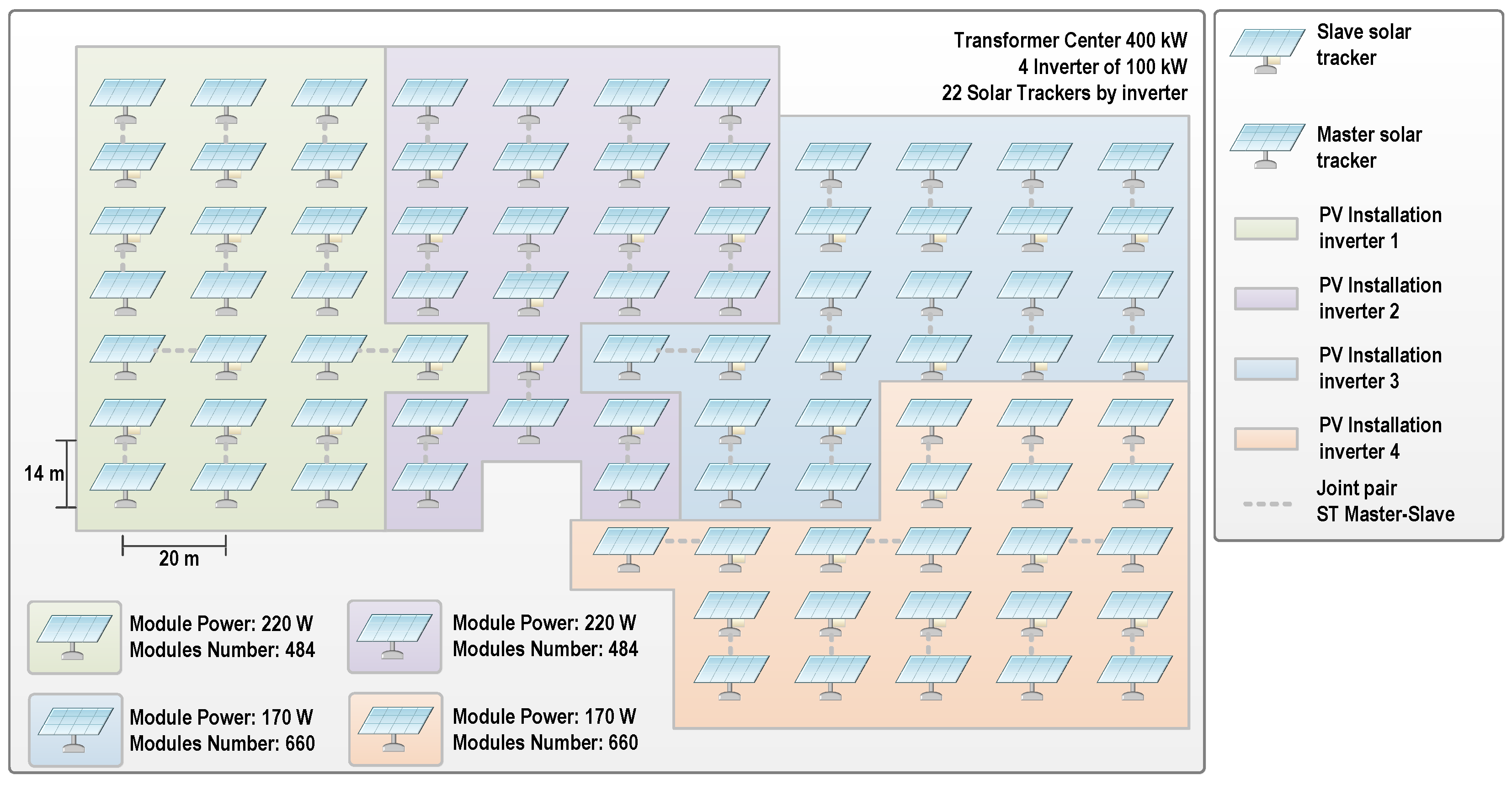





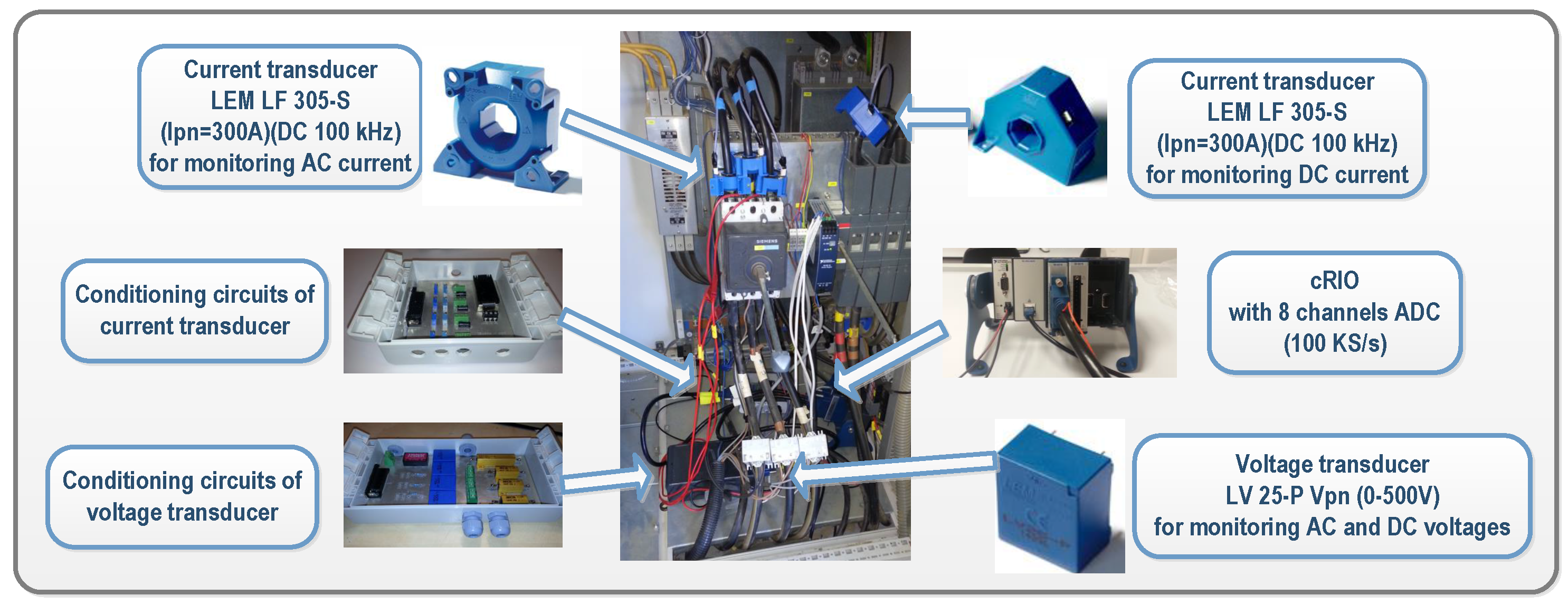



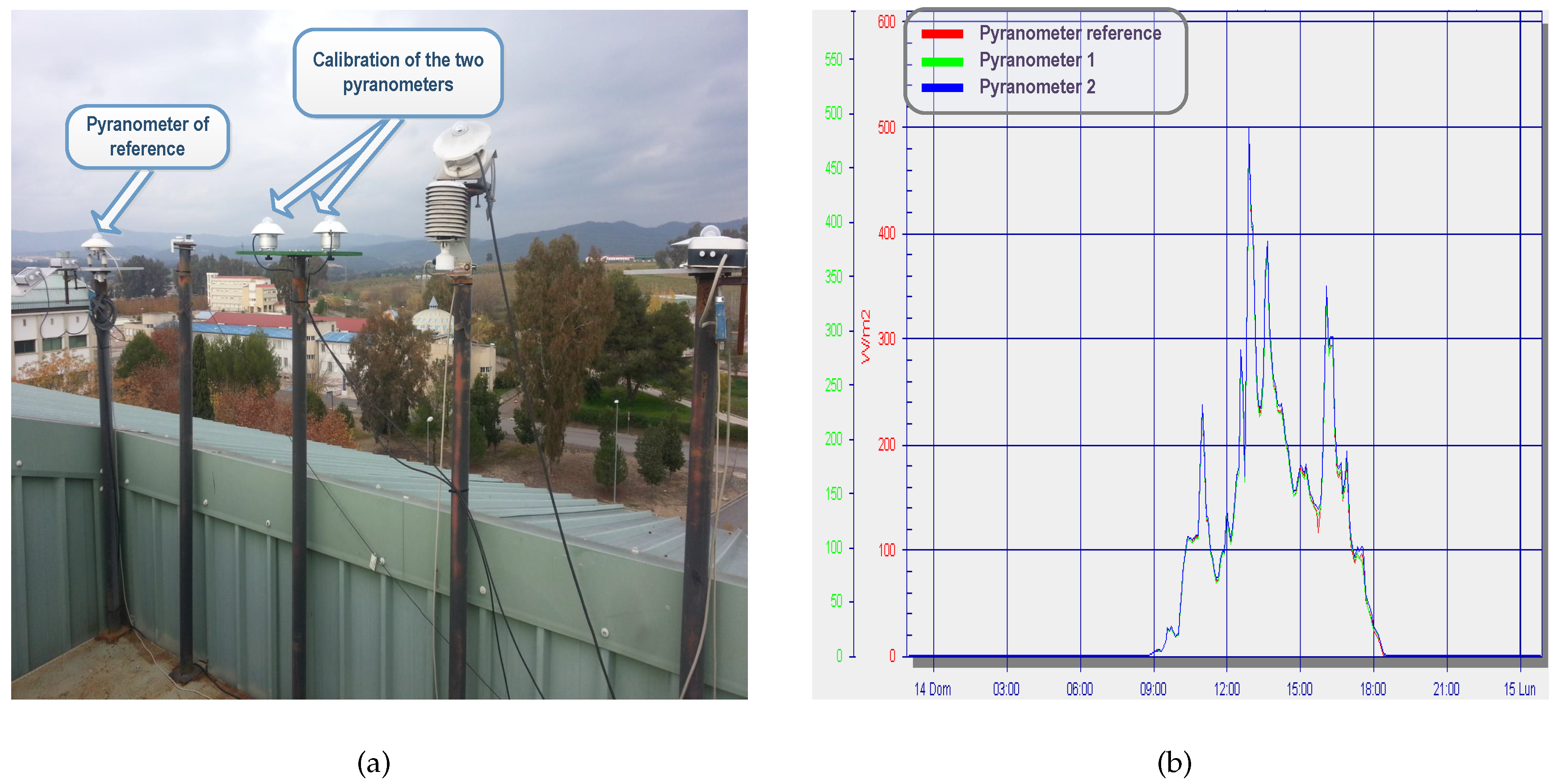



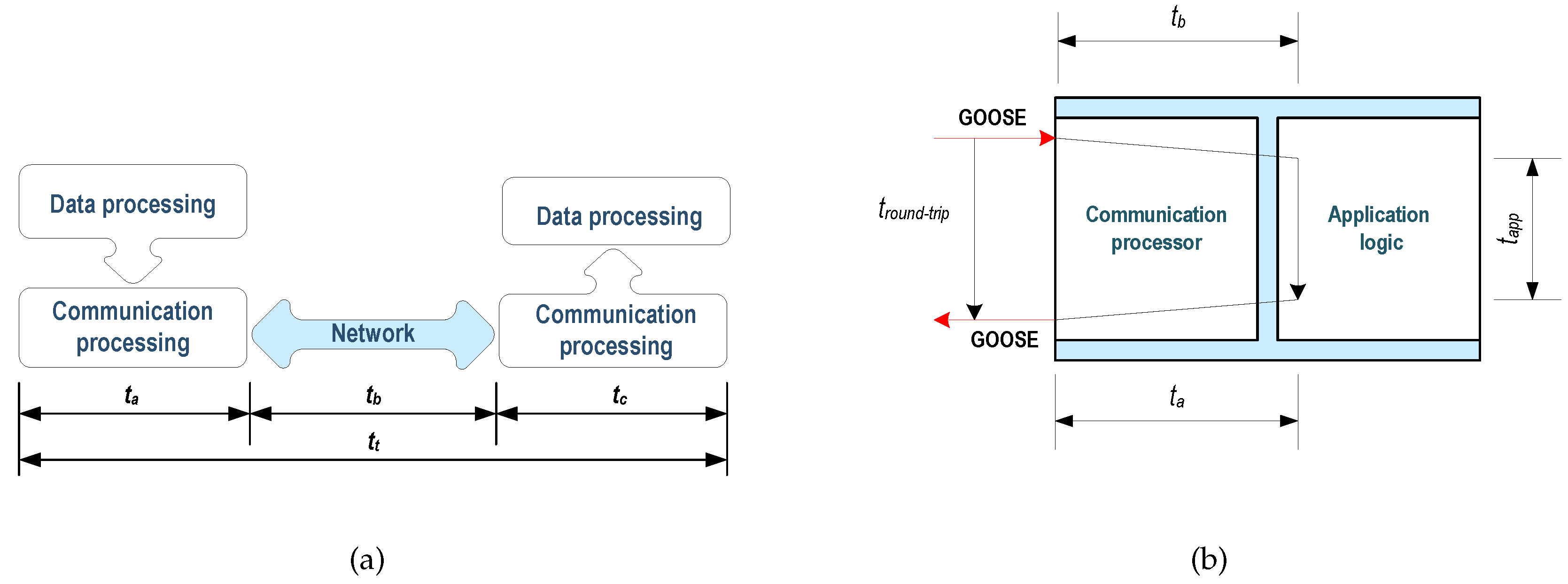
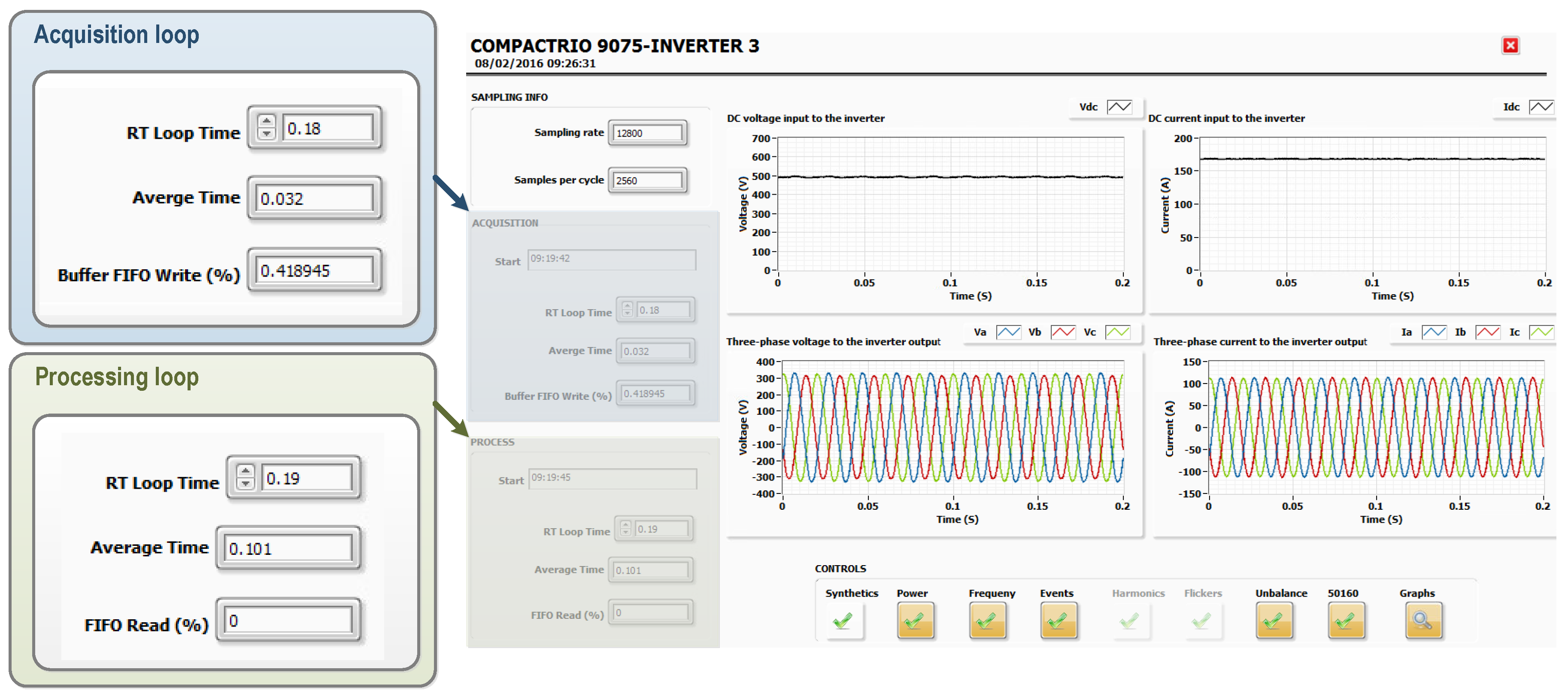
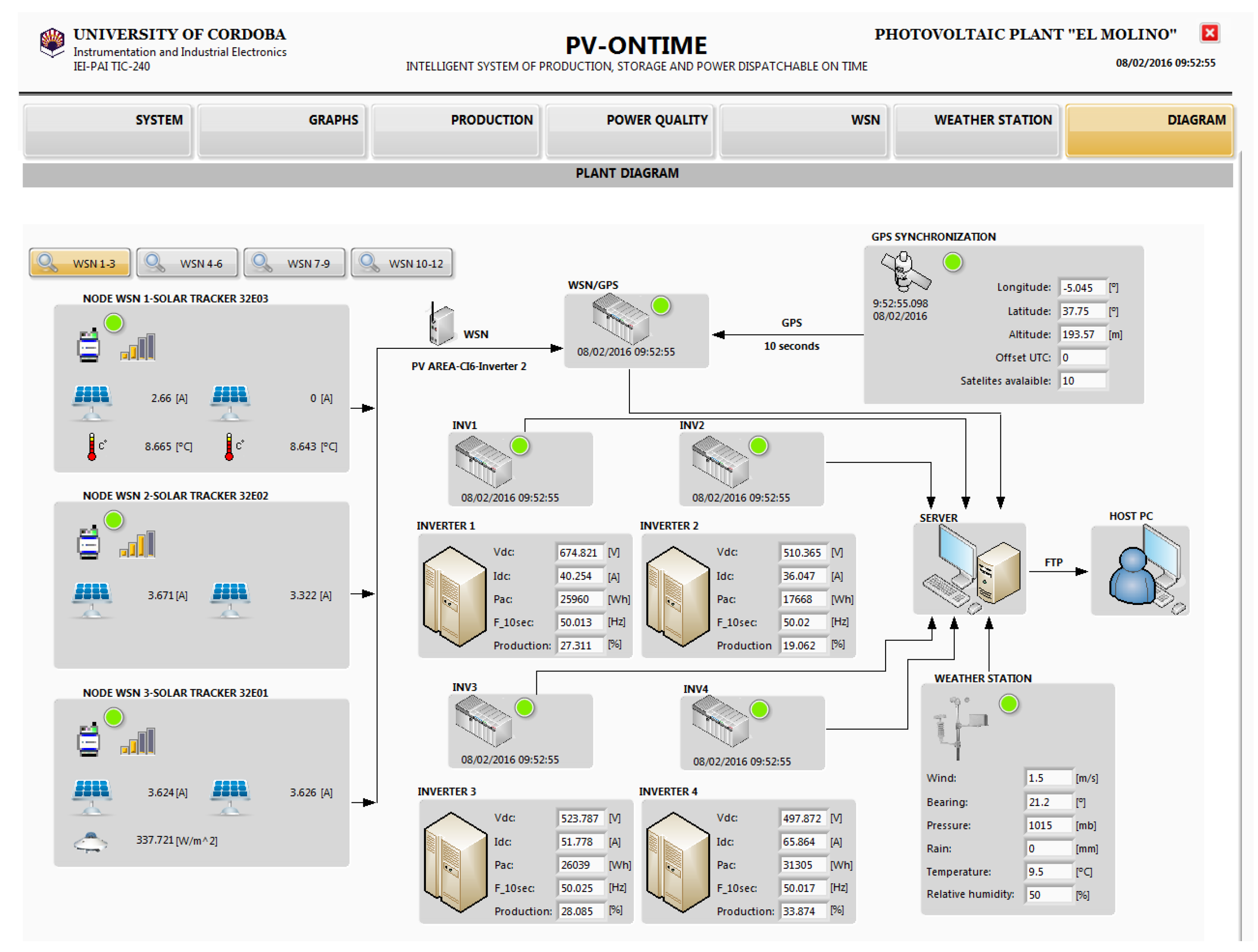
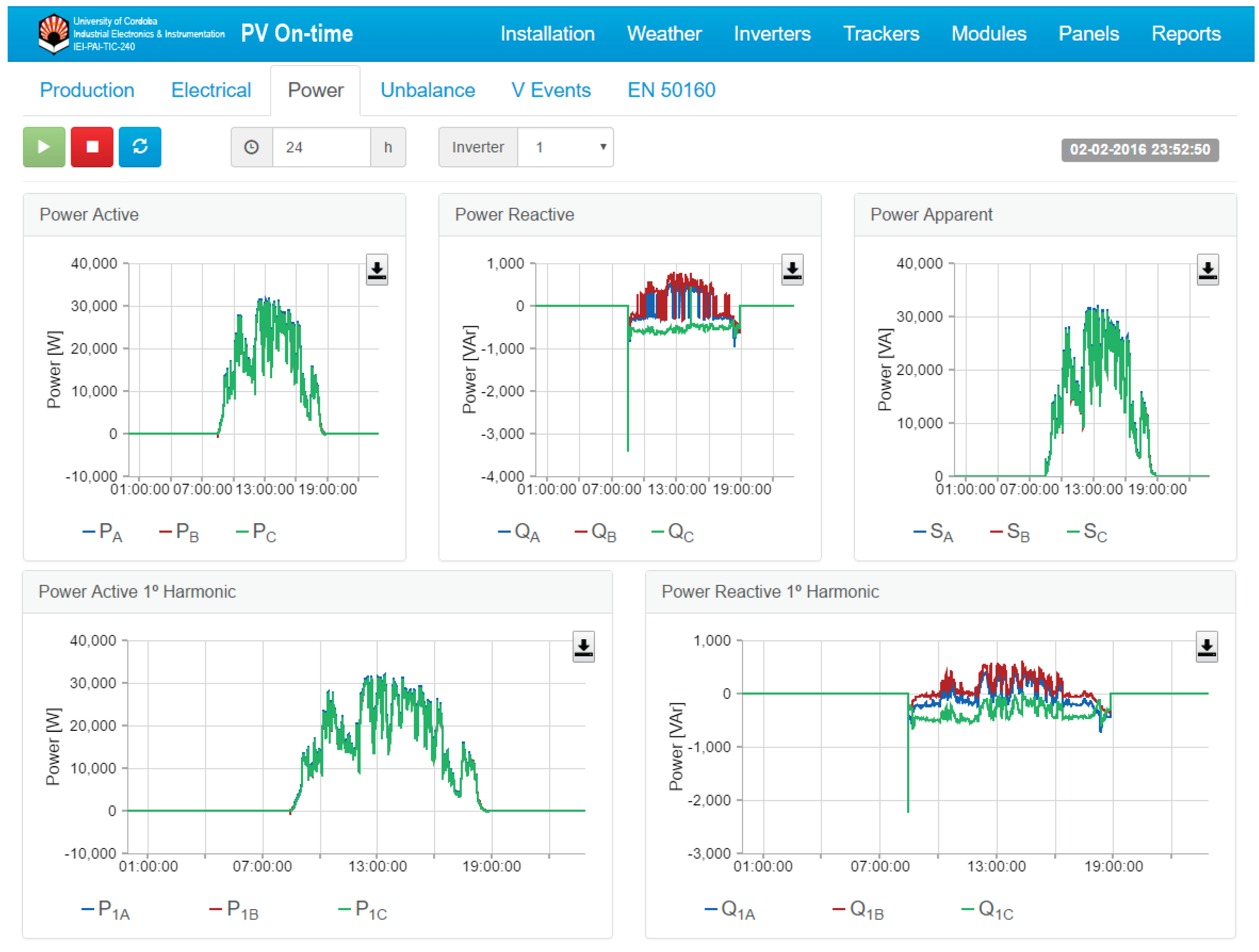
| Measurements | Computed | Intervals |
|---|---|---|
| One-cycle fundamental power values | 3-phase | 1 cycle |
| Power values | 3-phase | 10 cycles |
| Energy values | 3-phase | 10 cycles |
| Aggregated frequency 10 s values | 1-phase | 10 s |
| Voltage RMS values | 3-phase | 10 cycles, 3 s, 10 s, 10 m |
| Current RMS values | 3-phase | 10 cycles, 3 s, 10 s, 10 m |
| Voltage underdeviation | 3-phase | 10 cycles, 3 s, 10 s, 10 m |
| Voltage overdeviation | 3-phase | 10 cycles, 3 s, 10 s, 10 m |
| Voltage events | 3-phase | 1 cycle |
| Rapid voltage changes events | 3-phase | 1/2 cycle |
| Voltage total harmonic distortion (THD) | 3-phase | 10 cycles, 3 s, 10 s, 10 m |
| Voltage unbalance factor | 1 value for 3-phase | 10 cycles |
| Fundamental voltage unbalance factor | 1 value for 3-phase | 10 cycles, 3 s, 10 s, 10 m |
| Fundamental voltage symmetrical components | 1 value for 3-phase | 10 cycles |
| Current unbalance factor | 1 value for 3-phase | 10 cycles |
| Fundamental current unbalance factor | 1 value for 3-phase | 10 cycles |
| Harmonic voltage RMS values | 3-phase | 10 m |
| RTOS Linux | RTOS VxWorks | |||||
|---|---|---|---|---|---|---|
| Definition of the methodology used in the data transfer | ||||||
| DUT Function | Publish | Subscribe | Subscribe | Publish | Subscribe | Subscribe |
| cRIO Model | 9030 | 9066 | 9033 | 9024 | 9075 | 9074 |
| Message type | GOOSE | GOOSE | GOOSE | MMS | MMS | MMS |
| Evaluation of the times in the data transfer | ||||||
| PTP synchronism (μs) | 32 | 36 | 42 | 66 | 70 | 67 |
| Active power (ms) | 0.911 | 0.372 | 0.453 | 1.123 | 0.634 | 0.560 |
| Sag event (ms) | 0.914 | 0.455 | 0.513 | 1.033 | 0.552 | 0.510 |
© 2016 by the authors; licensee MDPI, Basel, Switzerland. This article is an open access article distributed under the terms and conditions of the Creative Commons Attribution (CC-BY) license (http://creativecommons.org/licenses/by/4.0/).
Share and Cite
Moreno-Garcia, I.M.; Palacios-Garcia, E.J.; Pallares-Lopez, V.; Santiago, I.; Gonzalez-Redondo, M.J.; Varo-Martinez, M.; Real-Calvo, R.J. Real-Time Monitoring System for a Utility-Scale Photovoltaic Power Plant. Sensors 2016, 16, 770. https://doi.org/10.3390/s16060770
Moreno-Garcia IM, Palacios-Garcia EJ, Pallares-Lopez V, Santiago I, Gonzalez-Redondo MJ, Varo-Martinez M, Real-Calvo RJ. Real-Time Monitoring System for a Utility-Scale Photovoltaic Power Plant. Sensors. 2016; 16(6):770. https://doi.org/10.3390/s16060770
Chicago/Turabian StyleMoreno-Garcia, Isabel M., Emilio J. Palacios-Garcia, Victor Pallares-Lopez, Isabel Santiago, Miguel J. Gonzalez-Redondo, Marta Varo-Martinez, and Rafael J. Real-Calvo. 2016. "Real-Time Monitoring System for a Utility-Scale Photovoltaic Power Plant" Sensors 16, no. 6: 770. https://doi.org/10.3390/s16060770






